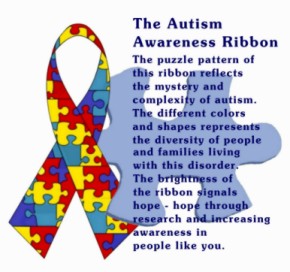|
Autism Spectrum
The Autism Spectrum includes five closely related disorders: Autism, Asperger's, Childhood Disintegrative Disorder, Rett's,
and PDD-Nos.

|
| www.designbycher.com |
AUTISM
Autism is much more common than what most people think. Affecting as many as 1 in 166 people. The rates of Autism have
increased dramatically over the last ten years. Due to the high rate of Autism many schools are experiencing difficulties
due to the increased need for funding.
Autism affects boys 4:1 more frequently that girls. Some studies I have found say that girls can on average be affected more
severely than boys. Autism appears to affect children before the age of three and affects the nuerological development of
children. Areas that can be affected are cognitive development, social development, behavioral areas, sensory areas, speech
and language, and motor areas.
Although children might have the same diagnosis of Autism, each child is affected differently. While some children might be
affected more severely. People need to keep in mind that mildly affected children still can have many difficulties with nonverbal
language, sensory issues, behavioral issues, an other issues.
Asperger's Syndrome usually affects children after the age of three. People with this disorder usually are affected more with
of social skills, behavioral areas, and nonverbal areas than in areas of cognitive development and in verbal speech.
Some children are gifted in areas of music, math, art, or other areas. Mamy children with aspergers can have problems with
gross motor issues or sensory issues as well. Some doctors might feel this is at the upper end of the spectrum. However, children
with this disorder also have many issues to can be very difficult for them.
Rett's Syndrome unlike Autism affects almost entirely girls. It is also very rare compare to rates of Autism. Girls
with this disorder have many characteristics of autism, but also show a decline in many areas.
PDD-Nos is also another term that many parents may hear. Many times doctors will use this term for Atypical Autism or when
a child has some of the traits or characteristics but not anough to give a specific Diagnosis.
For all of the Autism Spectrum disorders I will add links to informational below.
Check out our sister group, where I am posting different articles and statistics I find. Everyone is also welcome to add to
these articles which might be interesting to families. If you have links you would like to be posted please email me, and
I will post them here.
On a personal note: Having children on the Autism Specrum we have seen many sensory issues for all of our children and each
one has different issues. My youngest child particularly has had many sensory issues in regards to the vestibular area. (rocking,
spinning, jumping, head banging)We have learned that she is not alone.
Many children on the spectrum have sensory issues including hypersensitivities to sounds, lights, smells, and tastes. My son
has hypersensitivity to sounds and is scared of storms. My daughter is afraid of bathrooms.
There are also many different type of treatments out there for Autism including the casein/gluten free diet, medications,
homeoapathy, chiropractic therapies, speech therapy, occupational therapy, sensory intergration therapy, bio-therapies, special
education, applied behavior therapy, special diets, and many others...
Many children may also have developmental delays in the areas of reading, math, and writing as well. These problems are not
all uniform either... One of my children reads very well, but has problems with comprehension. This is the opposite for my
other child who has no problems with comprehension but has problems reading the material.
Some children also might show a talent in a certain area like music, math, art, spacial perception, ect... They may score
way above other children in a specific area.
Below are some links to information about Autism and resources.
|



